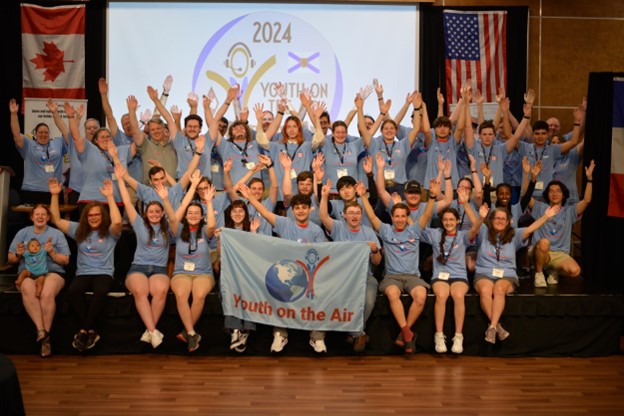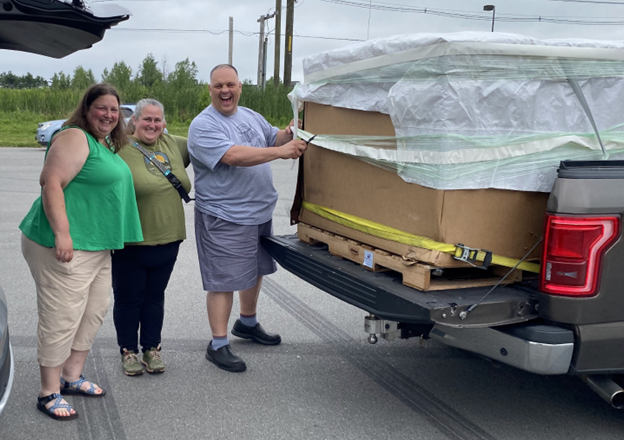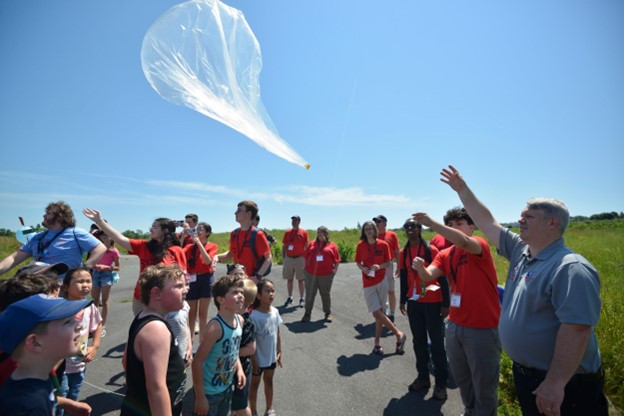Via the RSGB: Wick High School Radio Club collects time zones
 Read more at RSGB.co.uk
Read more at RSGB.co.uk  Read more at RSGB.co.uk
Read more at RSGB.co.uk  Read more at RSGB.co.uk
Read more at RSGB.co.uk  Read more at RSGB.co.uk
Read more at RSGB.co.uk  Read more at RSGB.co.uk
Read more at RSGB.co.uk  Read more at ARRL.org
Read more at ARRL.org  STEM coursework is available without cost to learners of all ages from the U.S. National Science Foundation National Radio Astronomy Observatory, thanks to funding from the Amateur Radio Digital Communications
STEM coursework is available without cost to learners of all ages from the U.S. National Science Foundation National Radio Astronomy Observatory, thanks to funding from the Amateur Radio Digital Communications Story by Katie Campbell, KE8LQR.
After seeing much success the first few years, Youth On The Air (YOTA) Camp in the Americas returned this past summer to Halifax, Nova Scotia. Approximately 30 campers from six different countries, ranging from 15 to 25 years old, attended.
Throughout the week, campers took part in sessions on satellite operating, high altitude ballooning, CW, soldering/kit building, POTA, and more—all led by other young people.
More importantly, the campers (including myself) had the opportunity to meet other young hams and form friendships that will last a lifetime.

Every YOTA camp is full of new adventures, and this year was no different.
We started planning for this year’s camp as soon as last year’s event in Ottawa ended, since planning an event through emails and Zoom meetings can be a little tedious. We started looking at details like what we would do during this year’s camp, where we’d host specific sessions on and off campus, and what sessions to have. Then we started creating the schedule.
By November 2023, we’d started writing press releases and posting information about camp to our social media to build excitement and spread the word about where and when it would be. We also started looking for young people to lead sessions, particularly returning campers from the previous years.
As we got closer to camp, we had Zoom meetings about once a month to discuss important issues and things that came up while we were emailing back and forth. It seemed like everything was straightened out and ready to go, but Murphy decided that would be the perfect time to remind us of his law:
Anything that can go wrong…will!
We arrived in Halifax the Friday before camp started and encountered a “small” problem. The pallets with nearly all of the supplies for camp were stuck at customs in Massachusetts, and the office would be closing in about half an hour.
We racked our brains for a solution and made a few phone calls.
Eventually, we connected with The Ham Radio Guy, Marvin, W0MET, who offered to drop everything, pick up the pallets, and even drive them to Maine to meet us at a halfway point so we could pick them up.
Very early the next morning, Julie Rapp and Colleen, KB8VAQ, started the 15-hour drive to Maine from Halifax while the rest of us stayed back and started setting up what we could. Finally, while we were at dinner, we got the message that Colleen and Julie had gotten through customs, crossed the border with the pallets, and would get back at about 2 am Sunday.
We all got up bright and early on Sunday and worked together as fast as we could to unload everything and set it up. We managed to get almost everything straightened out, although there would be a running joke throughout the week whenever we couldn’t find something:
“Where is X?”
“Oh, probably on the pallets!”

With setup complete and all t’s crossed and i’s dotted, camp was a go!
Campers started arriving at noon to get settled into their dorms at Mount Saint Vincent University and meet their roommates until the opening ceremony at five (watch a video of the opening ceremony here).
After the opening ceremony we had a quick tour of the shack and antennas before we could start operating. The next morning, we started the first day of camp with logging and SDR sessions. Then, the ID-52 handheld transceivers that Icom donated for us to use all week were passed out and our Icom rep, Rose, VA3RZZ, led a session about D-STAR.
After lunch, we headed outside for our pico balloon launch, led by Wintta, VA3WGY, and Stefan, VA3STQ.

Unfortunately, both balloons hit a storm a few hours later and went down just north of Sable Island.
After launching our balloons, we had sessions about nets and CW, followed by a session where campers and staff could share resources and groups for young hams. We all had dinner and then the final session of the day was “Train the Trainer,” where some of the camp staff explained how to run a YOTA camp, from planning and preparation to actually hosting the event.
Tuesday morning, campers split up into either a kit-building or ARDF session. After that, we had our ARISS contact, led by Ruth, KM4LAO. Tuesday evening, we had dinner in downtown Halifax before going on a tour of the city and the harbor. After the tour, it was back to the university for some operating time or socializing before lights out.
On Wednesday, we got to do some satellite operating before a presentation from Dr. Yaroslav “Yarko” Pustovyi about Maritime Launch Services. After his presentation, it was time to get ready to activate Georges Island the next day. Once we finished up our POTA prep, we had some more time to operate VE1YOTA or socialize.
On Thursday, it was time for POTA! We split up into groups and rotated which location we were operating from or touring. My group started out at the HMCS Sackville, where we got to tour the ship and learn more about its history before getting on the air with the station on board.
After we made some contacts there, it was time to head to Georges Island for POTA. We took a ferry over and got on the air straight away. After some antenna troubleshooting, we finally started making contacts and got a few really large pileups!
After that, my group took the ferry back and got to tour the Maritime Museum of the Atlantic and even operate from the station there. Then, it was time to go back to the university for dinner and shack/social time.
On Friday morning we had our closing ceremony (watch here), returned our radios, said our goodbyes, and started making plans to see each other at camp next year!
We’ve already started planning for camp in Denver, Colorado, and hope to see you there!
You can find information about YOTA Camp 2025 here. You can apply to attend starting December 1. Click here for the Denver 2025 YOTA Camp application page.
***
High school student Katie Campbell, KE8LQR, earned her Amateur Extra license at the age of 11. Among other activities, she teaches youth Morse code through the Long Island CW Club; helps out with her school’s amateur radio club, K8LPS; is a member of YACHT (Young Amateurs Communications Ham Team; was a featured presenter at Contest University 2024; and is on the planning committee and PR team for the YOTA group.
The post Youth On The Air Halifax 2024: Recapping a Memorable Amateur Radio Gathering appeared first on OnAllBands.
 Read more at RSGB.co.uk
Read more at RSGB.co.uk  Read more at RSGB.co.uk
Read more at RSGB.co.uk  Read more at RSGB.co.uk
Read more at RSGB.co.uk  Read more at RSGB.co.uk
Read more at RSGB.co.uk It’s a sad truth: Many people in the ham radio community never explore the opportunities afforded to them by their Technician license. You pored over the ham radio study guide, learned the basic math, asked your Elmer a million questions, and passed the test with flying colors.
But that’s as far as things progressed. It’s a common story: Life gets in the way.
While there are many reasons why new hams don’t make use of their first license, one of them isn’t a lack of opportunity to have a blast on the air. A Tech license opens up a vista of privileges, some of which are the coolest and most valuable among the long list of ham radio activities.
In today’s OnAllBands video, Michael Murphy, KI8R, DX Engineering customer/technical support specialist, shows some of the ways you can take advantage of punching your amateur radio ticket, along with encouraging words and practical advice on making your operating goals a reality.
But the question, “I just got my license. What’s next?” doesn’t just apply to new operators, as KI8R explains. Moving up the ham radio licensing ladder to General and Amateur Extra brings new opportunities but also may elicit more questions about how you may want to move into other areas of interest.
Enjoy the video below. And if you’re new to the hobby, welcome aboard! We can’t wait to hear you on the air!
We also recommend this excellent article by blogger Sean, KX9X, “Beyond Your Local Repeater: 15 Things to Do with a Technician License.”
Need help getting your first station together? DX Engineering offers handheld, mobile, base station, Go Box, and POTA ham radio getting started packages that take the worry out of choosing the right transceivers, antennas, and station components for your goals and budget.
The post So You Got Your Ham License? Here’s How to Start Enjoying Amateur Radio. (Video) appeared first on OnAllBands.
In response to a The Future of Amateur Radio is with our youth . . . not! by Joe Cupano, NE2Z (because his wordpress doesn’t allow comments, unless you’re logged in as admin to his site, lol.
To that headline, I say, the Future of Amateur Radio IS with our youth!
But youth is relative. Sure, there is a definition of youth, but I argue that youth in ham radio must take it’s aged demographic into consideration. The average ham (according to ARRL/NCJ and OFCOM data) is…old. The UK its over 71, the ARRL/NCJ is 70. So what is youth relative to 70 years old? What would at 70 year old tell you?
They would say to almost everyone younger than then, even a 50 year old, that they’re still young!
But that begs the question: what is old? Unfortunately, “old” has a very negative connotation (cranky, curmudgeonly, stinky, mean, burdensome, stubborn, and tech illiterate) while the positives (wise, elder, experienced, aged (like a fine wine or whisky), and virtuous) are often ignored.
Simply put, old is not young. And based on our relativity to ham radio, and removing as much connotation and subjectivity as possible, old is aged beyond that of the average ham radio licensee, which is about 70.
Lets actually read the post and not jump to conclusions about the title (can’t begin to tell you how much that happens on my blog. If you’re a reader of n0ssc.com I probably don’t have to remind you that Millennials Are Killing Ham Radio, but maybe I should have put a “…NOT” in that headline ).
).
Joe asks,
How many times have you seen the messaging in Amateur Radio that it’s future is with the youth and how the Amateur Radio community should engage them in teaching or demonstrating technology to them?
It’s bullshit!
It’s bullshit because he believes there is a double standard (I guess) where youth are failing to show hams how to use modern technology like cellphones, social media, maker tech, and videoconferencing, and that youth have surpassed the ham radio community in technology engagement.
I’ve mulled that one over.
It must be a symptom of his tunnel vision, or something, but I fail to see both the double standard, and the fact that young people aren’t teaching old people (and in Joe’s case, specifically hams) how to use tech. This, I think, is bullshit, because old folks are using tech, and using it well enough to present themselves on Zoom meetings, create and comment on Facebook posts, make YouTube videos of their ham radio fun (some pretty great!) and even make 3D printed thingies – THANKS ENTIRELY to…
Gotcha! You thought I was gonna say youth there, didn’t you?
First of all, the fact that old people still, in fact, have a brain and can still learn, often by themselves, nullifies Joe’s premise, but secondly, people who have either helped them learn (I currently don’t know a young ham who isn’t tech support for their grandma), or have made tech generally as accessible as possible for people of all ages and levels of technology literacy in the first place. And some of those helpful people happen to be young. Some are old, too. But what’s your point, Joe?
Joe mentions the overlooked “middle child” of generations – Millennials and GenXers (did I tell you Millennials Are Killing Ham Radio?) but I feel he left his point hanging there, but contextually, I assume he believes the reins of ham radio is in their hands but doesn’t consider those people “young.” I believe this to be true, but it’s just as important to bring ham radio into the minds and hands of GenX and Millennials as it is for GenZ, and those after that when they come of age, for the same reason why it’s of paramount importance (not to mention highly desirable) to have diversity in any community of peoples.
But maybe, ham radio has always been an old person’s hobby, and that’s just the way it is. Hiram Percy Maxim apparently stated that the age of hams was a problem…in 1900s (citation needed…someone told this to me at W4DXCC and I’ve not found a source, but I believe it!)
Even if that’s the case, imagine my disappointment when the old guard dies away without doing anything to bring new blood into ham radio, resulting in international amateur radio spectrum reallocation, resulting in no ham radio for me when I get to be old. That would suck, and that’s why I am the IARU R2 Liasion for Youth and a co-founder of Youth on the Air, and a die-hard evangelist for this hobby. I don’t have the time in my 20s and 30s to operate every day, go on mega DXpeditions, contest for 48 hours straight for 12 weekends out of the year and more, and win WRTC, because I’m working over full time while still having a life with my wife, dog and two cats, friends, and family, with the world to still see. I want ham radio to still exist when I retire, dammit!
(and also to give back to the community by making ham radio a valuable STEM sandbox for young people, as it did for me!)
So I will blog during my lunch hours, I’ll travel to a hamfest to give a talk a few times a year, and I’ll join a club’s zoom to help promote youth in ham radio. What are you doing to keep ham radio existing in perpetuity?
If anything, just get on the air!
Press Release by the Intrepid-DX Group
Wednesday, July 1, 2020
First Annual “Dream Rig” Youth Essay Contest.
The Intrepid-DX Group is a US based 501 C(3) nonprofit organization that promotes Amateur Radio activities in developing countries.
Announcing our first annual Youth Essay Contest-Prize is a Dream Rig!
The Intrepid-DX Group recognizes the importance of including Youth in our great hobby because they are our future! We are establishing an annual Dream Rig Youth Essay Contest to learn the suggestions of young people for attracting other young operators to Amateur Radio.
What is the Prize?
The prize is a factory fresh ICOM IC-7300! See the features here:
https://www.icomamerica.com/en/products/amateur/hf/7300/default.aspx
Contest Rules:
1) Two-page Essay answering these questions: A) What are your amateur radio goals? B) What can we do to attract more youth to amateur radio?
2) USA Amateur Radio License Holders Age 19 or younger.
3) Promise to keep the radio for one year, not flip it, trade it or sell it, and to use it on the air.
4) Send essay in text or MS Word attachment to intrepiddxgroup@gmail.com by July 31, 2020.
5) You may alternatively mail it to: The Intrepid-DX Group, 3052 Wetmore Dr, San Jose, CA 95148, USA.. Must be post marked by July 31, 2020.
6) The winner of the Essay Contest will be announced on our Website and Facebook page on August 10, 2020.
All submissions become the property of the Intrepid-DX Group and may be published.
Questions: Send an email to pauln6pse@gmail.com
Follow us on our homepage www.Intrepid-DX.com and/or our Facebook page at https://www.facebook.com/The-Intrepid-DX-Group-180857615282553